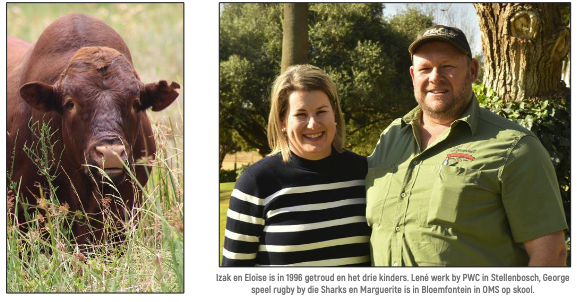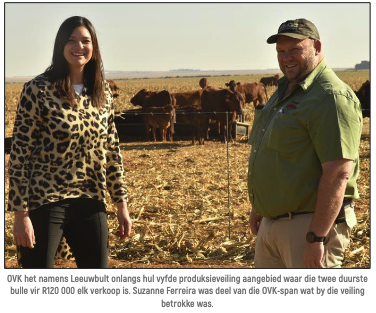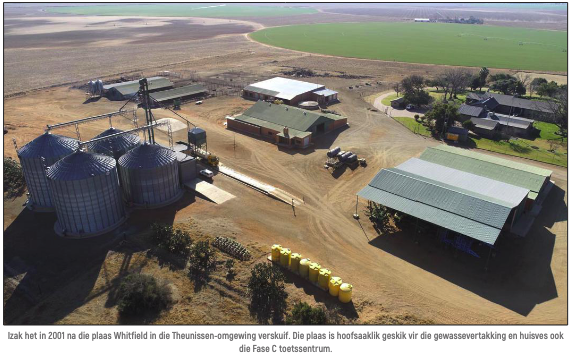Leeuwbult Bonsmara het onlangs hul vyde produksieveiling suksesvol in Theunissen aangebied. Ons het die stofpad aangedurf om by vierdegeslag beesboer Izak Cronjé en sy vrou Eloise te gaan kuier om meer oor hulle, die boerdery en die stoet uit te vind.
Izak se oupa het in die vyftigerjare van Vredefort na die Theunissen-omgewing getrek waar Izak se pa en hy ook grootgeword het. Izak het in 1989 aan Grey Kollege gematrikuleer en daarna die graad BSc Agric Veekunde aan die Universiteit van die Vrystaat verwerf.
Izak se pa is op 'n vroeë ouderdom oorlede en hy het na sy studies by sy oom Johan, wat 'n gevestigde boer was, gaan werk om ondervinding op te doen "Ek het 'n paar beeste en 'n plaas, Mooifontein, geërf maar vinnig besef dat ek nie gaan geld maak as ek nie baie beeste en baie grond het nie. Ek sou risiko's moes neem en by kontantgewasse betrokke raak. Die grond het meer weiding as lande gehad maar ek het ingeklim in die saaiery."
Izak en Eloise het mekaar op universiteit, waar sy regte studeer het, ontmoet en trou in 1996. Die plaas Mooifontein waarop hy toe geboer het nie 'n woonhuis gehad nie en hulle het vir 'n paar jaar op die buurplaas saam met sy broer Gert gewoon tot hy getrou het. "Ons koop toe die plaas, Helpmekaar, waar ons vir drie jaar gewoon het voordat ons Whitfield in 2001 gekoop het, waar ons nou gevestig is."

Die opstal is bo-op 'n bult en Izak kan vanuit sy kantoor die hele plaas met 'n groot hoeveelheid kameras op monitors teen die muur dophou. "Eloise se pa was 'n bankbestuurder en ek het 'n goeie klankbord in hom gehad wanneer ek groot finansiele besluite moes neem. Hy het altyd goeie finansiële raad gegee en gesê wat sal werk en wat nie."
Dit is nie algemeen dat ‘n boer ewe passievol oor vee en akkerbou is nie en Izak vertel ‘n staaltjie uit sy kinderdae. "My pa het met Afrikanerbeeste geboer. Soggens hef ons gegaan na waar al die werk uitgedeel word en dan lande toe om te kyk dat al die trekkers aan die gang kom. Wanneer ons teruggekom het, het ons dan 'n draai by die bulle in die stalle gemaak. My pa het dan vir 'n lang tyd na elke bul gestaan en kyk - en daar was seker 30 bulle!!! Ek kon dit nooit verstaan nie," sê Izak laggend.
Hy het sy kudde in 2003 van Afrikaner na Bonsmara verander. Whitfield is hoofsaaklik 'n saaiplaas met die Fase C-toetsstasie, maar die beeste wei op Mooifontein. Die naam "Leeuwbult" het 'n lang geskiedenis. "Nog voor die Anglo-Boereoorlog het my oupagrootjie, wat president van Afrikanertelergenootskap was, naby Winburg geboer. Sy plaas se naam was "Leeuwbult". Tydens die ontwikkeling van die Bonsmarras by Mara, was daar 'n Leeuwbultbul wat gebruik was en 'n groot invioed op die Bonsmara gehad het. Van daardie genetika is vandag in die Leeuwbultstoet teenwoordig.”
Sy liefde vir die Bonsmara is op verskeie eienskappe gebaseer. "Dit gaan oor sy aanpasbaarheid, hoë vrugbaarheid, goeie vleiseienskappe, gehardheid en 'n breë genepoel. Die Bonsmara is wetenskaplik ontwikkel vir plaaslike toestande, is winsgewend en seker die grootste beesras in Suid-Afrika.
“Elke koei moet elke jaar vir jou 'n kalf gee, so vrugbaarheid is baie belangrik. Hulle moet vinnig groei en vleis produseer van die veld af. Die gemiddelde reënval by ons is 470 mm per jaar en die diere loop vanaf Oktober tot Julie op natuurlike weiding en Smutsvinger. Ons gebruik dan die mieliereste na oestyd tot Desember indien nodig. Die tydsduur word bepaal deur laatreën en droogte en in hierdie droë toestande speel die loopvermoë deur dik sand, gehardheid en aanpasbaarheid 'n groot rol."
Alle diere word by die Leeuwbult Fase-C toetsstasie getoets asook miostatienmutasies en vaderskap word met DNA bevestig. Verse word vir 56 dae getoets en bulle vir 84 dae. Na seleksie wei beide geslagte op natuurlike veld en verse word gedek op 18 maande. "My doel is om diere te teël wat in enige gebied kan aanpas, anders beperk jy jou mark.
“Die kuddeprofiel is vir my baie belangrik. Dit skep 'n geheelbeeld van die kudde en waarmee die teler besig is. As ek by 'n veiling kom en na 'n bul kyk, wil ek in die profiel al die belangrike einskappe sien en wat die teler wil bereik."

Izak plant mielies en sojabone op besproeiings- en droëlande as somergewasse en koring op besproeiingslande as 'n wintergewas. Hulle kry water vir die spilpunte uit die kanaalsisteem vanaf die Erfenisdam tussen Theunissen en Winburg.
Hy verduidelik dat hulle jare se oes-statistieke versamel en dele van lande identifiseer wat meer bemesting benodig. Hulle pas ook die stand van die mielies daarby aan.
Hulle sal digter plant waar die opbrengs potensiaal hoer is. Hierdie oesseisoen was hulle tweede beste nog en hulle het ten minste 2 ton per hektaar meer af-gehaal as die vorige seisoen.
Hy is van mening dat produksie van voedsel al hoe belangriker gaan word maar dat die uitdaging groot is. "Die toekoms van landbou is positief, maar daar is dinge waarby ons verby sal moet kom. Ek sien nie werklik klimaatsverandering as n bedreiging nie, maar sien tog ekstreme. Die droë jare word droër en die nat jare, natter. Ek moet fokus op goed wat ek kan verander en die klimaat is nie een van hulle nie, so jy moet aanpas.
“Boerdery gaan vir my oor aanpasbaarheid. Jy moet aanpas by die omgewing waarin jy is, polities sowel as by die klimaat, diefstal, kragtekorte, ens. Dit is juis die aanpasbaarheid van Suid-Afrikaanse boere wat hulle sulke goeie boere maak."
Op die vraag oor die moontlikheid van El Niño-toestande is Izak heel reguit. "Die sekerste ding in die Vrystaat is droogte. Jy moet dit altyd in jou agterkop hou en besef dat ses uit tien jaar droog kan wees. As hulle El Niño voorspel, moet nou nie gaan kуk hoe dik jy kan plant nie, maar bring jou stand af dat hy binne aanvaarbare norme vir sulke toestande val. Onthou, 'n boer moet plant, want hy het uitgawes om te betaal.
Jy kan nie een oomblik in wees en dan weer uit nie. Boerdery werk nie so nie." Izak se toekomsvisie is om 'n volhoubare winsgewende boerdery te bedryf wat vir beeskopers meer waarde bied as waarvoor hulle betaal, om sodoende die Leeuwbult naam in die beesbedryf te vestig. Met 140 jaar se teelkennis in sy bloed en die wyse waarop hy en Eloise die boerderybesigheid bestuur, is daar geen twyfel dat hulle hierdie visie sal bewaarheid nie. Dan het George 'n groot begeerte om ná sy rugbyloopbaan plaas toe te kom. Die toekoms lyk baie belowend, daar bo-op die bult op Whitfield.

Bron: OVK Nuus September 2023
Leeuwbult Bonsmara recently held its fifth successful production auction in Theunissen. We dared to travel the dirt road to visit fourth-generation cattle farmer Izak Cronjé and his wife Eloise to learn more about them, their farming operation, and the stud.
Izak's grandfather moved from Vredefort to the Theunissen area in the 1950s, where Izak's father and he grew up. Izak matriculated from Grey College in 1989 and obtained a BSc Agric Animal Science degree from the University of the Free State.
Izak's father passed away at a young age. After his studies, he went to work with his uncle Johan, an established farmer, to gain experience. "I inherited a few cattle and a farm, Mooifontein, but quickly realized that I wouldn't make money if I didn't have many cattle and a lot of land. I had to take risks and get involved in cash crops. The land had more grazing than arable land, but I ventured into crop farming."
Izak and Eloise met at university, where she studied law and married in 1996. The Mooifontein farm on which he initially farmed did not have a residential house, so they lived on a neighbouring farm with his brother Gert for a few years until he married. "We then bought the farm Helpmekaar, where we lived for three years before purchasing Whitfield in 2001, where we are now established."

The homestead is located on a hill, and Izak can monitor the entire farm from his office with many cameras on monitors against the wall. "Eloise's father was a bank manager, and I had a good sounding board in him when I had to make significant financial decisions. He always gave good financial advice and told me what would work and what wouldn't."
It's rare for a farmer to be equally passionate about cattle and crop farming, and Izak shares a childhood story. "My father farmed with Afrikaner cattle. In the mornings, we went to where all the work was assigned and then to the fields to ensure all the tractors were running. When we returned, we would visit the bulls in the stables. My father would then stand and watch each bull for a long time - and there were probably 30 bulls!!! I could never understand it," Izak laughs.
He switched his herd from Afrikaner to Bonsmara in 2003. Whitfield is mainly a crop farm with the Phase C testing station, but the cattle graze on Mooifontein. The name "Leeuwbult" has a long history. "Even before the Anglo-Boer War, my great-grandfather was the president of the Afrikaner Cattle Breeders' Society, farmed near Winburg. His farm was named 'Leeuwbult.' During the development of the Bonsmara breed in Mara, there was a Leeuwbult bull that was used and had a significant impact on the Bonsmara breed. Some of that genetics are present in the Leeuwbult stud today."
His love for the Bonsmara breed is based on various qualities. "It's about their adaptability, high fertility, good meat qualities, resilience, and a broad genetic pool. The Bonsmara was scientifically developed for local conditions, is profitable, and is probably the largest cattle breed in South Africa.
"Every cow must give you a calf yearly, so fertility is essential. They need to grow quickly and produce meat from the field. Our average annual rainfall is 470 mm, and the animals graze on natural pasture and Smutsvinger from October to July. We use maize residues after harvesting until December if necessary. The duration depends on late rain and drought. In these dry conditions, running ability through thick sand, resilience, and adaptability play a significant role."
All animals are tested at the Leeuwbult Phase-C testing station, including myostatin mutations, and paternity is confirmed with DNA. Heifers are tested for 56 days and bulls for 84 days. After selection, both sexes graze on natural pasture, and heifers are mated at 18 months. "My goal is to breed animals that can adapt to any area; otherwise, you limit your market.
"The herd profile is very important to me. It creates a comprehensive view of the herd and what the breeder is working with. When I go to an auction and look at a bull, I want to see all the important traits in the profile and what the breeder wants to achieve."

Izak grows maize and soybeans as summer crops on irrigated and dryland and wheat as a winter crop on irrigated land. They get water for the pivot points from the canal system from the Erfenisdam between Theunissen and Winburg.
He explains that they collect years of harvest statistics and identify parts of land that need more fertilization. They also adjust the maize population accordingly.
They plant more densely where the yield potential is higher. This past harvest season was their second-best yet, and they harvested at least 2 tons per hectare more than the previous season.
He believes that food production is becoming increasingly important, but the challenge is significant. "The future of agriculture is positive, but there are things we need to overcome. I don't see climate change as a threat, but I do see extremes. Dry years are getting drier, and wet years, wetter. I need to focus on what I can change, and the climate is not one of them, so you have to adapt.
"Farming is about adaptability. You have to adapt to the environment you are in, politically as well as to the climate, theft, power shortages, etc. It is precisely the adaptability of South African farmers that makes them such good farmers."
Regarding the possibility of El Niño conditions, Izak is straightforward. "The surest thing in the Free State is drought. You must always keep it in mind and realize that six out of ten years can be dry. If they predict El Niño, don't try to push the limits of planting, but set your standards within acceptable norms for such conditions. Remember, a farmer has to plant because he has expenses to pay.
You can't be in one moment and out the next. Farming doesn't work like that." Izak's vision for the future is to run a sustainable, profitable farming operation that offers more value to cattle buyers than what they pay, thus establishing the Leeuwbult name in the cattle industry. With 140 years of breeding knowledge in his blood and the way he and Eloise manage the farming business, there is no doubt that they will achieve this vision. The future looks very promising up on the hill at Whitfield.

Source: OVK News September 2023
Geslagte van Beesteler-Passie